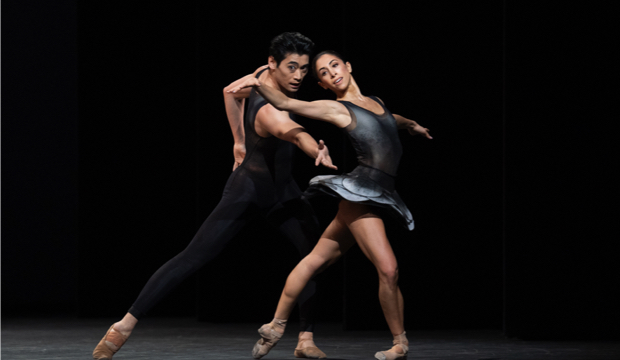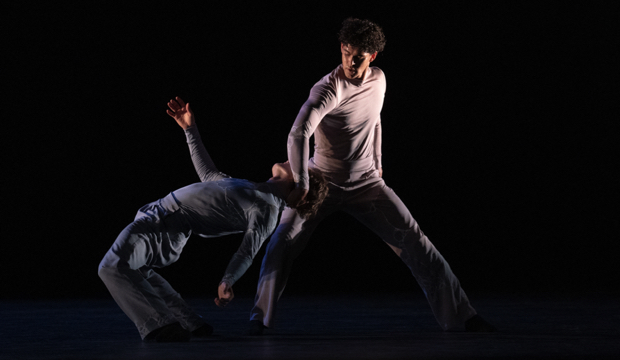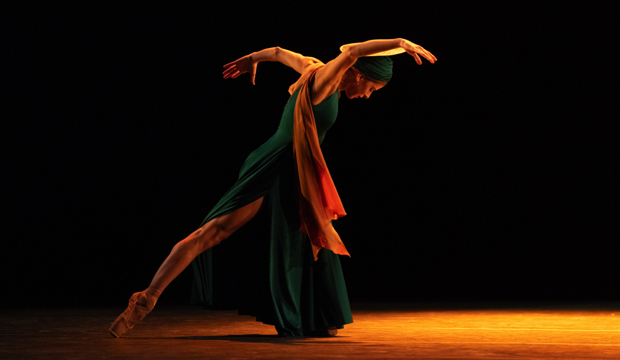Festival of New Choreography, New Works Review ★★★★★
Jessica Lang's Twinkle © 2024 ROH. Photo: Andrej Uspenski
There was neo-classical dance, a compelling display of new dance movement, a touch of African dance, and a charming homage to starry-eyed childhood innocence. Judging by this New Works programme of the ROH Festival of New Choreography, ballet still has many new things to tell us.
Danced by The Royal Ballet, the programme opened with Gemma Bond’s Boundless.

Ryoichi Hirano, Yasmine Naghdi in Gemma Bond's Boundless ©2024 ROH. Photo: Andrej Uspenski
A Brit now settled in the USA, Bond created a piece for a dozen dancers led by Yasmine Naghdi and Ryoichi Hirano, set to a restless concerto for two pianos by the Dutch composer Joey Roukens, and stylishly dressed in black and soft greyish blue by Charlotte MacMillan. In its fast, energetic, unceasing neo-classical movement with plentiful extensions and a variety of lifts, it is clearly influenced by William Forsythe.
A totally different mood enveloped the next work on the programme, Joshua Junker’s Never Known.A first artist with the Royal Ballet, Junker has already made his mark as a choreographer in the UK and his native Netherlands, and Never Known again demonstrates his talent and innovative thinking.

Liam Boswell, Francisco Serrano in Joshua Junker's Never Known © 2024 ROH. Photo: Andrej Uspenski.
The opening, with a group of 20 dancers in pale pastel casual costumes massed in a pool of light projected from above (the whole evening’s lighting design was by Zeynep Kepekli), was strongly reminiscent of Crystal Pite, whose work Junker professes to admire immensely.
However, Never Known soon broke away from Pite to come into its own, with liquid movement that uses the whole body in unexpected ways, and is at one with the music of Nils Frahm and Vikingur Olafsson in its often dark, questioning mood.
The South African dancer and choreographer Mthuthuzeli November has long transcended his association with Ballet Black by creating work for a variety of companies; but For What It’s Worth is his first commission for The Royal Ballet.
It’s a piece full of colour (African-inspired costumes by Yann Seabra) lit in warm, sunny hues, which seeks to blend the percussive dance of his Xhosa culture with the steps of classical ballet, the women in pointe shoes. Mayara Magri was affecting as the Miriam Makeba-inspired Mamma Africa figure, her opening solo powerful and involving.

Mayara Magri in Mthuthuzeli November's For What it's Worth ©2024 ROH. Photo: Andrej Uspenski
Finally, Jessica Lang’s charming Twinkle (pictured top) sent us home in a happy and dreamy mood. Inspired by the childhood lullaby Twinkle Twinkle Little Star, the American choreographer created a work of intense beauty and musically set to Brahms’s Cradle Song and Mozart’s Twelve Variations, popularly known as Twinkle Twinkle Little Star, played on the piano by Kate Shipway.
READ CULTURE WHISPER'S INTERVIEW WITH JESSICA LANG HERE
It’s about the childhood fascination with stars; Lang’s own set design has a large twinkling light piece suspended high above the stage to our right; but it’s also about the dancers, all 10 of which get their individual moment to shine.
Lang’s vocabulary is classical with playful tweaks. At times the dancers’ hands flutter in unison like twinkling stars; they fleet across the stage like ephemeral streaks of light. Most enchanting of all were principals William Bracwell and Fumi Kaneko, both stars in more ways that one.
Danced by The Royal Ballet, the programme opened with Gemma Bond’s Boundless.

Ryoichi Hirano, Yasmine Naghdi in Gemma Bond's Boundless ©2024 ROH. Photo: Andrej Uspenski
A Brit now settled in the USA, Bond created a piece for a dozen dancers led by Yasmine Naghdi and Ryoichi Hirano, set to a restless concerto for two pianos by the Dutch composer Joey Roukens, and stylishly dressed in black and soft greyish blue by Charlotte MacMillan. In its fast, energetic, unceasing neo-classical movement with plentiful extensions and a variety of lifts, it is clearly influenced by William Forsythe.
A totally different mood enveloped the next work on the programme, Joshua Junker’s Never Known.A first artist with the Royal Ballet, Junker has already made his mark as a choreographer in the UK and his native Netherlands, and Never Known again demonstrates his talent and innovative thinking.

Liam Boswell, Francisco Serrano in Joshua Junker's Never Known © 2024 ROH. Photo: Andrej Uspenski.
The opening, with a group of 20 dancers in pale pastel casual costumes massed in a pool of light projected from above (the whole evening’s lighting design was by Zeynep Kepekli), was strongly reminiscent of Crystal Pite, whose work Junker professes to admire immensely.
However, Never Known soon broke away from Pite to come into its own, with liquid movement that uses the whole body in unexpected ways, and is at one with the music of Nils Frahm and Vikingur Olafsson in its often dark, questioning mood.
The South African dancer and choreographer Mthuthuzeli November has long transcended his association with Ballet Black by creating work for a variety of companies; but For What It’s Worth is his first commission for The Royal Ballet.
It’s a piece full of colour (African-inspired costumes by Yann Seabra) lit in warm, sunny hues, which seeks to blend the percussive dance of his Xhosa culture with the steps of classical ballet, the women in pointe shoes. Mayara Magri was affecting as the Miriam Makeba-inspired Mamma Africa figure, her opening solo powerful and involving.

Mayara Magri in Mthuthuzeli November's For What it's Worth ©2024 ROH. Photo: Andrej Uspenski
Finally, Jessica Lang’s charming Twinkle (pictured top) sent us home in a happy and dreamy mood. Inspired by the childhood lullaby Twinkle Twinkle Little Star, the American choreographer created a work of intense beauty and musically set to Brahms’s Cradle Song and Mozart’s Twelve Variations, popularly known as Twinkle Twinkle Little Star, played on the piano by Kate Shipway.
READ CULTURE WHISPER'S INTERVIEW WITH JESSICA LANG HERE
It’s about the childhood fascination with stars; Lang’s own set design has a large twinkling light piece suspended high above the stage to our right; but it’s also about the dancers, all 10 of which get their individual moment to shine.
Lang’s vocabulary is classical with playful tweaks. At times the dancers’ hands flutter in unison like twinkling stars; they fleet across the stage like ephemeral streaks of light. Most enchanting of all were principals William Bracwell and Fumi Kaneko, both stars in more ways that one.
TRY CULTURE WHISPER
Receive free tickets & insider tips to unlock the best of London — direct to your inbox
| What | Festival of New Choreography, New Works Review |
| Where | Royal Opera House, Bow Street, Covent Garden, London, WC2E 9DD | MAP |
| Nearest tube | Covent Garden (underground) |
| When |
15 Feb 24 – 21 Feb 24, 16, 20 and 21 Feb at 19:30. Dur.: 2 hours 30 mins approx inc one interval |
| Price | £3-£50 |
| Website | https://www.roh.org.uk/tickets-and-events/festival/festival-of-new-choreography-2024-dates/new-works-festival-of-new-choreography |